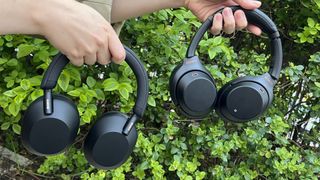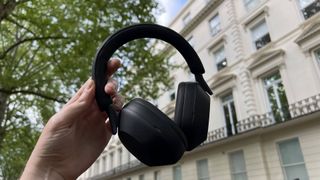Sony WH-1000XM5 vs WH-1000XM4: should you buy the new flagship noise-cancelling headphones?
Are Sony's new wireless headphones a worthy successor?

Thanks in no small part to Sony itself, the high-end sector of the wireless noise-cancelling over-ear headphones market has never been more competitive.
The success of 2018’s WH-1000XM3 and 2020’s WH-1000XM4 inspired a number of brands to deliver their own competing wireless headphones, and so consumers are utterly spoiled for choice.
Sony has ruled the roost, though – its models have consistently combined across-the-board performance with competitive pricing and, as a result, it has generally been regarded as the best option.
So with the WH-1000XM5 announced and about to hit store shelves, it seems only reasonable to ask if they are a worthwhile upgrade on the WH-1000XM4. Let’s find out.
Sony WH-1000XM5 vs Sony WH-1000XM4: price and availability
The WH-1000XM5 cost $399 / £379 / AU$649 at launch, and even though American buyers seem to be getting the best of that deal, there’s no denying it's a pricey pair of headphones wherever you live.
Certainly, it's pricier than the WH-1000XM4 – although that’s hardly surprising. Right now you should expect to pay around $349 / £269 / AU$499 but let’s face it, that price is only going one way: down.
At launch, you’re looking at around a $50 savings by choosing the older – and still very good – Sony WH-1000XM4. It’s a sizable chunk of change and, more importantly, it’s a gap that could widen as the year goes on and we drift towards the big shopping holidays like Black Friday and Cyber Monday. At some point in the future, we’re likely to see the Sony WH-1000XM4 dip below the $300 mark before plummeting to half-price. At that price, the Sony WH-1000XM4 is a no-brainer.
Get daily insight, inspiration and deals in your inbox
Get the hottest deals available in your inbox plus news, reviews, opinion, analysis and more from the TechRadar team.
So if you’re keen to snatch up a bargain and don’t mind wearing an older model then you might want to grab the XM4s when they hit their low point later this year.

Sony WH-1000XM5 v Sony WH-1000XM4: design
It’s safe to say the Sony XM5 headphones are a greater departure, where design is concerned, from the XM4 than the XM4 was from the XM3. That’s not to say Sony has torn up the rule book – the XM5 could never be confused for anything other than over-ear headphones. But it’s distinct from the XM4 to the point that you’d never confuse the two.
The WH-1000XM5 features minimal branding on a very slender hinge. The headphones are made of ABS plastic with pleather-covered memory foam at the contact points. In a word, these headphones look sophisticated.
Unlike the XM5, the XM4 folds in on itself, which makes it a slightly better choice for frequent travelers. At 254g it’s light, too - though the XM5 are a few grams lighter.

Sony WH-1000XM5 v Sony WH-1000XM4: spec and features
The XM5 uses Bluetooth 5.2 for wireless connectivity, with compatibility with SBC, AAC and LDAC codecs – which is a predictable step up from the Bluetooth 5.0 standard used by the XM4. Neither features any aptX codec compatibility, which remains a bit of a bugbear.
Both models are compatible with Sony’s 360 Reality Audio spatial algorithm – all that’s required is for you to upload a picture of each of your ears to the Sony Headphones control app. Plus, both are able to connect to two devices simultaneously, which is handy for those that like swapping between a laptop and a phone.
The most significant difference in specification concerns the drivers used to deliver sound. The 40mm drivers fitted to the XM4 are broadly comparable to those fitted to the majority of rival designs. The WH-1000XM5, though, uses 30mm mica-reinforced cellular drivers – however, size isn’t everything as we’ll learn in a minute.
Each model can be controlled using voice assistants, but also have a reliable and intuitive capacitive touch surface and physical control buttons. The XM5 takes a slight lead though thanks to its new ‘Ok Google’ functionality, but frankly either pair of headphones are easy to use.

Sony WH-1000XM5 v Sony WH-1000XM4: sound quality
The major reason the WH-1000XM4 met with such universal acclaim back in 2020 was its sound quality - after all, what’s a pair of headphones for? Even with a newer Sony model out that hasn’t changed: they’re detailed, offer supreme control of low-frequency sounds and feature a dynamic and impressive soundstage to boot.
That being said, the XM5 is no pushover, and while Sony hasn’t made a huge improvement compared to its predecessor, the XM5 is an improvement nonetheless. These headphones offer a better transient response and a more punchy, yet-just-as-controlled bass. Higher tones also sound more pronounced, too.
It just goes to show that you shouldn’t judge a pair of headphones by the size of its drivers.
Sony WH-1000XM5 v Sony WH-1000XM4: noise-cancellation
Both Sony models use active noise-cancellation and both have an ‘ambient sound’ option that can amplify external sound for when you need to pay attention to the world around you.
That being said, the ANC on XM5 is much better than what’s come before. To make its noise cancellation top-notch Sony has doubled the amount of microphones in the Sony WH-1000XM5 from four to eight and added a second dedicated processor in the form of the Sony V1. Two processors working in tandem help reduce the amount of audible noise in the midrange and the high-end audio spectrum significantly while keeping low-end noises like jet engines at bay. By comparison, the XM4’s noise-cancellation is still solid, but its performance has lagged behind some other brands like Bose.

Meanwhile, the XM5 headphones bring Sony back into the forefront, with ANC that can eliminate the majority of the external racket around you to give you an isolated listening experience.
Sony WH-1000XM5 v Sony WH-1000XM4: battery life
With one notable exception, there’s little to distinguish the older Sony from the newer in terms of battery life. Both will run for 30 hours or so with ANC switched on, and if it’s switched off the XM4 are good for around 38 hours while the XM5 will last for 40. Both take around three hours to go from empty back up to full charge, and both will run for several hours after a 15-minutes pit-stop.
Where the XM5 has the edge though is that it’s compatible with super-rapid USB-PD charging. Even if you can only spare three minutes, USB-PD can deliver three hour’s worth of action.
Sony WH-1000XM5 v Sony WH-1000XM4: takeaway
With the WH-1000XM5 Sony has delivered a pair of wireless over-ear headphones that offer a new distinct look, make modest gains in sound quality, and take the noise-cancellation to an all-new level.

That being said, the WH-1000XM4 isn’t out of the running. These headphones are considerably more affordable and offer an equally good battery life. Sure, the XM4 isn’t quite as impressive audio-wise but it isn’t leagues behind either.
Really it comes down to whether you’re after the best-of-the-best with the Sony WH-1000XM5 or if you’re happy to accept some generally minor downgrades to go with the more budget-friendly Sony WH-1000XM4 headphones.
Simon Lucas is a senior editorial professional with deep experience of print/digital publishing and the consumer electronics landscape. Based in Brighton, Simon worked at TechRadar's sister site What HiFi? for a number of years, as both a features editor and a digital editor, before embarking on a career in freelance consultancy, content creation, and journalism for some of the biggest brands and publications in the world.
With enormous expertise in all things home entertainment, Simon reviews everything from turntables to soundbars for TechRadar, and also likes to dip his toes into longform features and buying guides. His bylines include GQ, The Guardian, Hi-Fi+, Metro, The Observer, Pocket Lint, Shortlist, Stuff T3, Tom's Guide, Trusted Reviews, and more.
Most Popular



